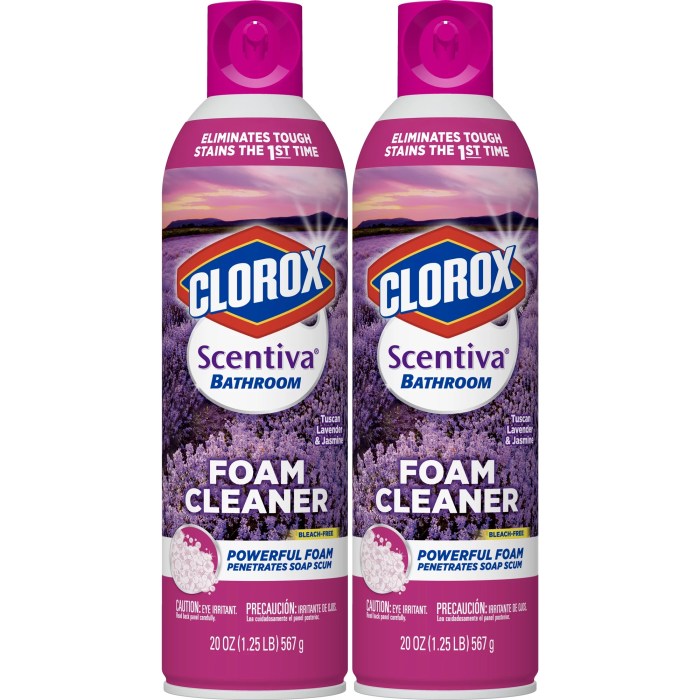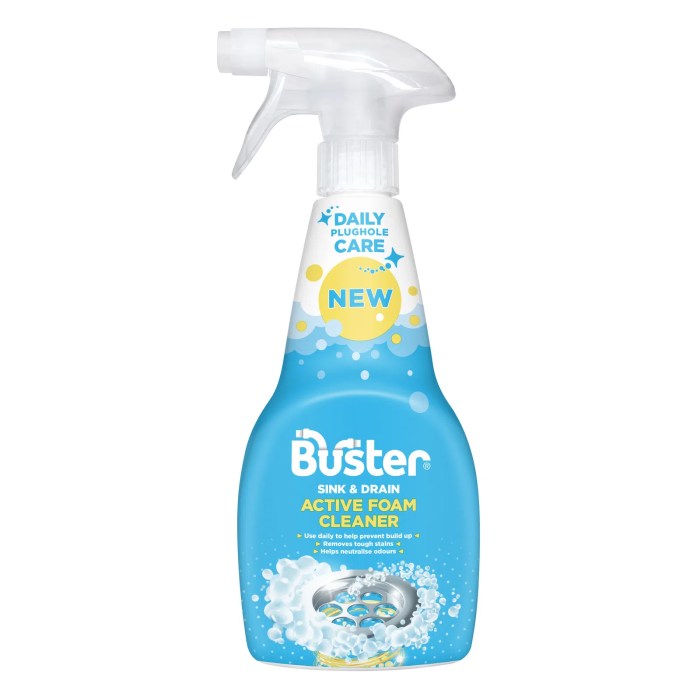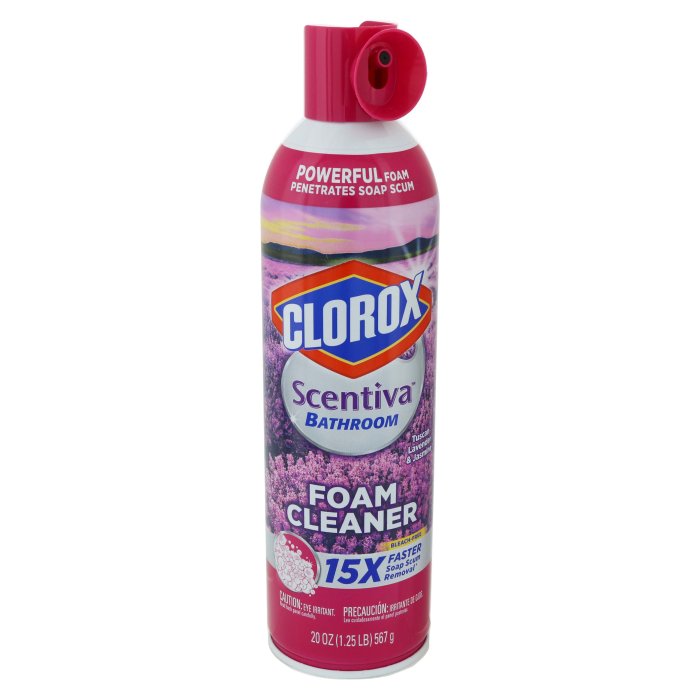Foam sink cleaners, the unsung heroes of household cleaning, take center stage in this comprehensive guide. Dive into the world of foam sink cleaners as we explore their purpose, advantages, types, applications, safety considerations, and environmental impact. Get ready to conquer clogged drains and grimy sinks with the power of foam!
From understanding the science behind foam sink cleaners to mastering their effective use, this guide provides a deep dive into the world of sink cleaning. Whether you’re a seasoned cleaning pro or a novice seeking a spotless sink, this guide has something for everyone.
Foam Sink Cleaner Overview

Foam sink cleaners are specialized cleaning agents designed to effectively remove dirt, grime, and stains from sinks. These cleaners typically come in a foam form, which helps them adhere to the surface of the sink, allowing for a more thorough cleaning process.
Foam sink cleaners often contain a combination of surfactants, solvents, and other cleaning agents that work together to break down and dissolve dirt and grime.
Advantages and Disadvantages
Foam sink cleaners offer several advantages over other cleaning methods:
- Easy to use:Foam sink cleaners are simple to apply and require minimal effort to clean sinks.
- Effective cleaning:The foam form allows the cleaner to adhere to the surface of the sink, ensuring thorough cleaning.
- Safe on surfaces:Foam sink cleaners are generally safe to use on most sink surfaces, including porcelain, stainless steel, and acrylic.
However, foam sink cleaners also have some disadvantages:
- Can be more expensive:Foam sink cleaners tend to be more expensive than other cleaning methods.
- May not be suitable for all surfaces:Some foam sink cleaners may not be suitable for use on certain surfaces, such as natural stone or copper.
- Can be harsh on skin:Some foam sink cleaners may contain harsh chemicals that can be irritating to the skin.
Types of Foam Sink Cleaners
Foam sink cleaners are categorized based on their ingredients and formulations, each type designed for specific cleaning purposes. Understanding the different types helps in selecting the most suitable cleaner for your sink’s needs.
Based on Ingredients
- Acidic Cleaners:Contain acids like hydrochloric acid or muriatic acid, effectively dissolving mineral deposits and soap scum. Ideal for removing tough stains and clogs.
- Alkaline Cleaners:Formulated with bases like sodium hydroxide or potassium hydroxide, these cleaners are effective in removing organic matter, grease, and food residue.
- Enzyme-Based Cleaners:Utilize enzymes to break down organic matter, making them suitable for removing food stains and odors.
- Bleach-Based Cleaners:Contain bleach, such as sodium hypochlorite, which acts as a disinfectant and whitener, removing stains and killing bacteria.
Based on Formulations
- Foaming Gel:A thick, gel-like formula that adheres to vertical surfaces, providing extended contact time for effective cleaning.
- Foaming Spray:A spray-on formula that creates a thick foam, making it suitable for cleaning larger areas or hard-to-reach spots.
- Foaming Powder:A powdered formula that dissolves in water, creating a foamy solution for cleaning.
Applications of Foam Sink Cleaners

Foam sink cleaners are versatile cleaning solutions suitable for a wide range of surfaces and materials. They are commonly used in both residential and commercial settings to maintain the cleanliness and hygiene of sinks and other bathroom fixtures.
Foam sink cleaners are particularly effective for removing dirt, grime, soap scum, and other residues that accumulate on sink surfaces. They can be used on various materials, including porcelain, ceramic, stainless steel, and acrylic. Their foaming action helps to penetrate and lift away stubborn stains and debris, leaving surfaces sparkling clean.
Step-by-Step Instructions for Using Foam Sink Cleaners
- Apply a generous amount of foam sink cleaner to the surface of the sink.
- Allow the foam to sit for a few minutes to penetrate and dissolve the dirt and grime.
- Use a sponge or cloth to gently scrub the surface, paying attention to areas with stubborn stains.
- Rinse the sink thoroughly with clean water to remove the cleaner and any loosened debris.
- Wipe the sink dry with a clean cloth or towel to prevent water spots and streaks.
Safety Considerations
Foam sink cleaners, while effective at removing dirt and grime, can pose potential hazards if not handled and stored properly. It is crucial to take necessary safety precautions to ensure the well-being of individuals using and handling these products.
The primary hazards associated with foam sink cleaners are their chemical composition and potential for skin irritation. The active ingredients in these cleaners are often harsh chemicals that can cause irritation or even burns if they come into contact with the skin or eyes.
Foam sink cleaner is an essential tool for keeping your sinks clean and free of clogs. For a more heavy-duty solution, consider expanda foam bunnings , which can expand to fill and seal cracks and gaps. This can help prevent leaks and keep your sink functioning properly.
Finish off with foam sink cleaner to ensure a sparkling clean finish.
Additionally, the foaming action can create airborne particles that can be inhaled and cause respiratory irritation.
Safe Handling and Storage
To minimize the risks associated with foam sink cleaners, it is essential to follow proper safety guidelines during handling and storage:
- Wear protective gear:Always wear gloves and eye protection when using foam sink cleaners to prevent direct contact with the skin and eyes.
- Ventilate the area:Ensure adequate ventilation when using foam sink cleaners to minimize the inhalation of airborne particles.
- Avoid mixing with other chemicals:Do not mix foam sink cleaners with other cleaning products, as this can create hazardous reactions.
- Store safely:Store foam sink cleaners in a cool, dry place out of reach of children and pets. Keep the containers tightly closed to prevent spills and leaks.
- Dispose of properly:Dispose of empty foam sink cleaner containers according to local regulations to prevent environmental contamination.
Environmental Impact
The environmental impact of foam sink cleaners is a significant concern due to their potential to pollute water sources and harm aquatic life.
Biodegradability, toxicity, and disposal methods play a crucial role in assessing their environmental impact.
Biodegradability
Biodegradability refers to the ability of a substance to break down naturally into simpler compounds by microorganisms.
- Some foam sink cleaners contain biodegradable surfactants that can be broken down by bacteria and other organisms in the environment.
- However, certain non-biodegradable ingredients, such as synthetic polymers and fragrances, can persist in the environment for extended periods.
Toxicity, Foam sink cleaner
Toxicity refers to the harmful effects of a substance on living organisms.
- Many foam sink cleaners contain surfactants that can be toxic to aquatic life, particularly fish and invertebrates.
- The toxicity of foam sink cleaners varies depending on the specific ingredients used and their concentration.
Disposal Methods
Proper disposal of foam sink cleaners is essential to minimize their environmental impact.
- Do not pour foam sink cleaners down the drain, as they can contaminate water sources.
- Dispose of empty foam sink cleaner containers in accordance with local regulations for hazardous waste.
Conclusion

Foam sink cleaners, with their versatility, effectiveness, and ease of use, are a must-have in every household. As you embark on your sink-cleaning journey, remember the tips and precautions Artikeld in this guide. Embrace the power of foam and transform your sink into a sparkling oasis of cleanliness.
FAQ Insights: Foam Sink Cleaner
What are the advantages of using foam sink cleaners?
Foam sink cleaners offer several advantages over traditional liquid cleaners. They cling to surfaces longer, allowing for deeper penetration and more effective cleaning. Their thick consistency helps prevent splashing and reduces the risk of inhaling harmful fumes.
How often should I use a foam sink cleaner?
The frequency of use depends on the level of usage and buildup in your sink. For regular maintenance, once a week is generally sufficient. However, if your sink experiences heavy use or frequent clogging, you may need to use a foam sink cleaner more often.
Can foam sink cleaners damage my pipes?
Most foam sink cleaners are safe for use in both metal and plastic pipes. However, it’s always a good practice to check the product label and follow the manufacturer’s instructions to avoid any potential damage.